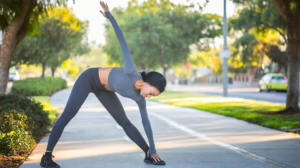Core Strength Matters: Why a Strong Core is Essential for Athletic Performance
Introduction
In sports and physical activities, athletes often focus on specific skills relevant to their disciplines, such as speed, agility, and strength. However, one element is commonly overlooked: core strength. The core is more than just a group of muscles; it plays a critical role in overall performance, injury prevention, and movement efficiency. This article explores the importance of core strength for athletic performance, examining the anatomical, physiological, and functional aspects that make a strong core essential for athletes in all sports.
Understanding the Core
Before diving into the significance of core strength, it’s essential to understand what the core encompasses. The core is a complex group of muscles that includes:
-
Rectus Abdominis: Often referred to as the "six-pack," this muscle is vital for flexing the lumbar spine and maintaining abdominal pressure.
-
Transverse Abdominis: This deep muscle lies beneath the rectus abdominis and plays a key role in stabilizing the spine and pelvis.
-
Internal and External Obliques: These muscles assist in rotational movements and flexibility, crucial for sports requiring twisting actions.
-
Erector Spinae: A group of muscles running along the spine, they provide support and stability during lifting and bending motions.
-
Multifidus: Located at the back, these small muscles stabilize the vertebrae and are essential for spinal health.
- Pelvic Floor Muscles: These muscles provide a base of support for the abdominal and lower back muscles and assist in core stability.
Together, these muscles facilitate movement, protect the spine, and contribute to athletic skills such as sprinting, jumping, and weightlifting.
The Role of Core Strength in Athletic Performance
1. Enhancing Stability and Balance
A strong core provides a stable base for all movements. Whether an athlete is executing a jump, sprinting on a track, or changing direction on a field, core muscles help maintain balance. Improved stability allows for more effective force transfer throughout the body, enabling athletes to perform at their best.
For instance, in sports like gymnastics or figure skating, where balance is paramount, a well-developed core enables an athlete to maintain control during complex maneuvers. Research shows that athletes with better core stability demonstrate superior balance and coordination—qualities critical for performance in many sports[^1].
2. Improving Power Generation
Power in sports comes from the ability to generate force quickly. The core acts as a conduit for transferring energy from the lower body to the upper body and vice versa. A strong core optimizes this energy transfer, allowing for more explosive movements.
Take sprinting, for example. Efficient running mechanics require an explosive push-off from the legs. The power generated in the legs must be effectively transmitted through the core to the upper body. Studies indicate that athletes with strong core muscles are able to generate more power, resulting in faster sprint times and improved performance in high-intensity situations[^2].
3. Injury Prevention
One of the most significant benefits of core strength is injury prevention. A strong core helps maintain proper alignment and posture during physical activities, reducing the risk of injuries to the spine, hips, and knees. Weak core muscles can lead to poor movement mechanics, which increases the likelihood of injuries due to strain or impact.
For instance, in sports like football and soccer, athletes frequently change direction while running. A weak core can lead to instability, contributing to various injuries, including hamstring strains and knee ligament tears. Research has shown that athletes with stronger cores are less likely to experience such injuries, underscoring the need for targeted core strength training as part of conditioning programs[^3].
4. Enhancing Endurance
Core strength is also crucial for endurance athletes. In longer events, such as marathons or triathlons, maintaining efficient body mechanics becomes increasingly challenging as fatigue sets in. A strong core supports effective posture, allowing athletes to maintain optimal alignment for extended periods.
Moreover, core strength helps to minimize extraneous movements that can waste energy. For example, cyclists with stronger cores can maintain a more stable position on the bike, allowing them to pedal effectively without unnecessary fatigue. This efficiency is crucial over long distances, where small improvements in energy conservation can lead to significant performance gains[^4].
Core Training: Effective Strategies for Athletes
Given the importance of core strength, athletes can utilize various training strategies to enhance this fundamental aspect of their performance.
1. Functional Exercises
Functional exercises mimic movements typical in sports, engaging the core in specific ways that translate to improved performance. Examples include:
-
Planks: Engaging the entire core and promoting stability.
-
Russian Twists: Strengthening the obliques and enhancing rotational power.
- Dead Bugs: Improving coordination and stability while engaging the core.
Incorporating these exercises into training routines can significantly improve core strength and stability, enhancing overall athletic performance.
2. Incorporating Pilates and Yoga
Both Pilates and yoga emphasize core strength, flexibility, and balance, making them excellent supplementary practices for athletes. Pilates focuses on controlled movements and core engagement, while yoga enhances flexibility and body awareness. Incorporating these modalities can improve core strength, reduce tension, and enhance mental focus—all beneficial for athletes[^5].
3. Progressive Resistance Training
Utilizing resistance in core workouts can lead to significant strength gains. Exercises like medicine ball throws, kettlebell workouts, and resistance band routines can add variety to training sessions while promoting core engagement. Strengthening core muscles with resistance allows for a more comprehensive approach to enhancing performance.
4. Sport-Specific Drills
Integrating core strength exercises into sport-specific drills can provide functional benefits. For instance, a soccer player can practice core engagement while performing ball-control drills or shooting exercises. This tailored approach ensures that athletes develop core strength that directly translates to their sport.
Assessing Core Strength
To adequately train the core, it’s essential to assess its strength and functionality. Various assessments can provide insights into an athlete’s core strength, such as:
-
Plank Test: Measuring the time an athlete can maintain a plank position helps gauge endurance and stability.
-
Side Plank Test: Assessing oblique strength and lateral stability.
- Stability Ball Pass: Evaluating core strength and coordination by passing a stability ball while in a tabletop position.
Conducting regular assessments can help athletes track their progress, set goals, and adapt training programs as needed.
Conclusion
Core strength is undoubtedly a cornerstone of athletic performance. From improved stability and power generation to injury prevention and endurance, a strong core facilitates a range of athletic capabilities. By recognizing its significance, athletes can incorporate targeted core strength training into their routine, enhancing their overall performance and achieving their competitive goals.
References
[^1]: Glatthorn, J. F., et al. (2018). "The Role of Core Stability in the Performance of Athletes." Journal of Sports Sciences. [^2]: Behm, D. G. & Sale, D. G. (1993). "Maximal Force Training: The Interaction of Resistance and Power Training." Sports Medicine. [^3]: Kibler, W. B., et al. (2006). "The Role of Core Stability in Athletic Performance." Sports Medicine. [^4]: McKean, M. R. et al. (2017). "Effects of Core Training on Endurance Performance in Triathletes." International Journal of Sports Physiology and Performance. [^5]: Karp, J. R. (2009). "Using Pilates to Enhance Athletic Performance." Athletic Therapy Today.In conclusion, the essence of core strength is undeniable. Athletes at all levels must establish a strong core foundation to excel in their sports while minimizing the risk of injury. Through targeted training and a focus on functional strength, athletes can leverage the power of their core to reach new heights in performance.


























Add Comment